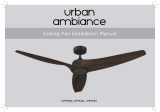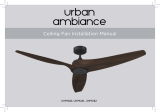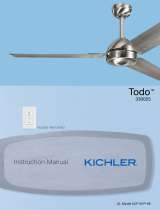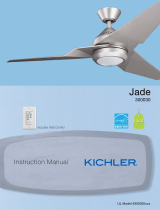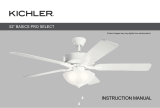Page is loading ...

Ceiling Fan Installation Manual
P2598
93099652_A

Date Purchased
Store Purchased
Model No.
Serial No.
Vendor No.
UPC
109226
785247000000
785247000000
Limited Lifetime Warranty
Progress Lighting fan motors are warranted to the original purchaser to be free of electrical and/or mechanical defects for so
long as the original purchaser owns the fan. Pull chain switches, reverse switches, capacitors and metal finishes are warranted to
be free from defects in materials or workmanship for a period of 1 year from the date of purchase. Warping of wooden or plastic
blades is not covered by this warranty nor is corrosion and/or deterioration of any finishes for fans installed within ten miles of
any sea coast. Extended warranties for ENERGY STAR
®
qualified products may apply.
Progress Lighting ceiling fans with built-in LED light sources, when properly installed and under normal conditions of use, are
warranted to be free from defects in material and workmanship which cause the light sources to fail to operate in accordance
with the specifications for (i) five (5) years from the date of purchase on the LED Light modules and electrical components for
fans used in single family residences, and (ii) three (3) years from the date of purchase on the LED Light modules and electrical
components for fans used in multi-family or commercial applications. LED bulbs supplied by Progress Lighting carry no
warranty other than manufacturer’s warranty. Non-LED bulbs carry no warranty.
With proof of purchase, the original purchaser may return the defective fan to the place of purchase during the first 30 days for
replacement. After 30 days, the original purchaser MUST contact Progress Lighting at (864) 678-1000 for repair or replacement
which shall be determined in Progress Lighting’s sole discretion and shall be purchaser’s sole and exclusive remedy.
Labor and Shipping Excluded. This warranty does not cover any costs or fees associated with the labor (including, but not
limited to, electrician’s fees) required to install, remove, or replace a fan or any fan parts.
This warranty shall not apply to any loss or damage resulting from (i) normal wear and tear or alteration, misuse, abuse or
neglect, or (ii) improper installation, operation, repair or maintenance by original purchaser or a third party, including without
limitation improper voltage supply or power surge, use of improper parts or accessories, unauthorized repair (made or
attempted) or failure to provide maintenance to the fan.
THE FOREGOING WARRANTIES STATE PROGRESS LIGHTING’S ENTIRE WARRANTY OBLIGATION AND
ORIGINAL PURCHASER’S SOLE AND EXCLUSIVE REMEDY RELATED TO SUCH PRODUCTS. PROGRESS
LIGHTING IS NOT RESPONSIBLE FOR DAMAGES (INCLUDING INDIRECT, SPECIAL, INCIDENTIAL OR
CONSEQUENTIAL), DUE TO PRODUCT FAILURE, WHETHER ARISING OUT OF BREACH OF WARRANTY,
BREACH OF CONTRACT, OR OTHERWISE. THIS WARRANTY IS GIVEN IN LIEU OF ALL OTHER WARRANTIES,
WHETHER EXPRESSED OR IMPLIED, INCLUDING THOSE OF MERCHANTABILITY, FITNESS FOR A PARTICULAR
PURPOSE OR NONINFRINGEMENT.
Some states do not allow limitations on how long an implied warranty lasts or the exclusion or limitations of incidental or
consequential damages, so the above limitations and exclusions may not apply to you. This warranty gives you specific rights
and you may have other rights which vary from state to state.

Table of Contents
Safety Rules.....................................................................................................................................................................................
Unpacking Your Fan .......................................................................................................................................................................
Installing Your Fan ..........................................................................................................................................................................
Installing the Light Kit.....................................................................................................................................................................
Operating Your Fan .........................................................................................................................................................................
Care of Your Fan ...........................................................................................................................................................................
Troubleshooting ............................................................................................................................................................................
Specifications ................................................................................................................................................................................
1.
2.
3.
8.
9.
10.
11.
12.

1. Safety Rules
1. To reduce the risk of electric shock, insure electricity has been turned off
at the circuit breaker or fuse box before beginning.
2. All wiring must be in accordance with the National Electrical Code and
local electrical codes. Electrical installation should be performed by a
qualified licensed electrician.
3. WARNING: To reduce the risk of electrical shock and fire, do not use
this fan with any solid-state fan speed control device.
4. WARNING: To reduce the risk of fire, electric shock, or personal
injury, mount to outlet box marked "Acceptable for Fan Support of 15.9
kg (35 lbs.) Or Less" and use mounting screws provided with the outlet
box. Most outlet boxes commonly used for the support of light fixtures
are not acceptable for fan support and may need to be replaced. Due to
the complexity of the installation of this fan, a qualified licensed
electrician is strongly recommended.
WARNING
TO REDUCE THE RISK OF FIRE, ELECTRIC SHOCK OR PERSONAL
INJURY, MOUNT FAN TO OUTLET BOX MARKED ACCEPTABLE FOR
FAN SUPPORT.
5. The outlet box and support structure must be securely mounted and
capable of reliably supporting a minimum of 35 lbs (15.9 kg) or less.
Use only cUL-listed outlet boxes marked FOR FAN SUPPORT.
6. The fan must be mounted with a minimum of 7 ft (2.1m) clearance from
the trailing edge of the blades to the floor.
7. Avoid placing objects in the path of the blades.
8. To avoid personal injury or damage to the fan and other items, be
cautious when working around or cleaning the fan.
9. Do not use water or detergents when cleaning the fan or fan blades. A
dry dust cloth or lightly dampened cloth will be suitable for most
cleaning.
10. After making electrical connections, spliced conductors should be
turned upward and pushed carefully up into the outlet box. The wires
should be spread apart with the grounded conductor and the
equipment-grounding conductor on one side of the outlet box.
11. Electrical diagrams are for reference only. Light kits that are not
packed with the fan must be cUL Listed and marked suitable for use
with the model fan you are installing. Switches must be cUL General
Use Switches. Refer to the Instructions packaged with the light kits
NOTE
READ AND SAVE ALL INSTRUCTIONS!
WARNING
TO REDUCE THE RISK OF PERSONAL INJURY, DO NOT BEND THE
BLADE ARMS (ALSO REFERRED TO AS BRACKETS) DURING
ASSEMBLY OR AFTER INSTALLATION. DO NOT INSERT OBJECTS IN
THE PATH OF THE BLADES.

Unpack your fan and check the contents. You should have the following items:
Unpacking Your Fan 2.
13. Loose parts bag containing:
a. Blade attachment hardware
(16 screws, 16 fiber washers)
b. Mounting hardware
Wire nuts (3)
c. Blade bracket attachment hardware
1 screw with lock washer
d. Electrical hardware
Pull chains (2)
1. Fan blades (5)
2. Canopy assembly
3. Ball/downrod assembly
4. Coupling cover
5. Set of blades bracket (5)
6. Motor cover
7. Fan motor assembly
8. Mounting plate
9. light kit assembly
10. Glass shade
11. LED medium base bulbs (2)
12. Balancing kit
1
2
5
9
12
10
11
6
7
8
3
4
13
a
c
b
d

Tools Required
Phillips screw driver, straight slot screw driver,
adjustable wrench, step ladder, and wire cutters.
Mounting Options
If there isn't an existing cUL listed mounting
box, then read the following instructions.
Disconnect the power by removing fuses or
turning off circuit breakers.
Secure the outlet box directly to the building
structure. Use appropriate fasteners and building
materials. The outlet box and its support must be
able to fully support the moving weight of the
fan (at least 35 lbs). Do not use plastic outlet
boxes.
Figure
1
Figure
3
Figure
4
Figure
2
Outlet box
Outlet box
Outlet box
Note: You may need a longer downrod to
maintain proper blade clearance when installing
on a steep, sloped ceiling.
To hang your fan where there is an existing
fixture but no ceiling joist, you may need an
installation hanger bar as shown in Figure 4
(available at your Progress Lighting Retailer).
3. Installing Your Fan
WARNING
TO REDUCE THE RISK OF FIRE, ELECTRIC
SHOCK, OR OTHER PERSONAL INJURY,
MOUNT FAN ONLY TO AN OUTLET BOX
MARKED ACCEPTABLE FOR FAN SUPPORT
AND USE THE MOUNTING SCREWS
PROVIDED WITH THE OUTLET BOX. OUTLET
BOXES COMMONLY USED FOR THE
SUPPORT OF LIGHTING FIXTURES MAY NOT
BE ACCEPTABLE FOR FAN SUPPORT AND
MAY NEED TO BE REPLACED. CONSULT A
QUALIFIED ELECTRICIAN IF IN DOUBT.
Angled ceiling
maximum
18.5 angle
Recessed
outlet box
Provide strong support
Ceiling
hanger
bracket

4.
Attaching the Fan Blades
NOTE: Your fan blades are reversible. Select
the blade side finish which best accentuates
your decor.
Step 1 Attach blades to blade arms using three
screws and fiber washers as shown in Fig. 5.
Start a screw into the arm, do not tighten.
Repeat for the 2 remaining screws and
washers.
Step 2 Tighten each screw securely starting
with the center screw. Make sure the blade is
straight.
Step 3 Fasten the blade assembly to the motor
using the motor screws provided. (Fig. 5)
Attaching the Motor Cover
Step 1 Remove the six screws and lock washers
from the motor collar. (Fig. 6)
Step 2 Place the motor cover over the motor. Align
the mounting holes with the holes in the motor and
fasten using the six screws and lock washers
previously removed. (Fig. 6)
Figure 5
Figure 6
Screws
Screws
Motor
Blade
Blade arm
Fiber
washers
Screws
Motor
cover
Motor
collar

5.
Figure 8
Figure 9
Figure 7
Ceiling hanger
bracket
Ceiling
canopy
Canopy
cover
Ceiling
hanger
bracket
Mounting screws
(supplied with
electrical box)
CUL Listed
electrical
box
120V Wires
Washers
Supply wires
Downrod
Hanger pin
Lock pin
Set screws
Canopy
Canopy cover
Collar cover
Pin in locked
position
Safety cable
Hanging the Fan
REMEMBER to turn off the power. Follow
the steps below to hang your fan properly:
Step 1. Remove the decorative canopy bottom
cover from the canopy by turning the cover
counter clockwise.(Fig. 7)
Step 2. Remove the mounting bracket from
the canopy by removing the 1 of 2 screws
from the bottom of the mounting bracket and
loosening the other one a half turn from the
screw head. Next, turn the canopy counter
clockwise to removing the mounting bracket
from the canopy. (Fig. 7)
Step 3. Pass the 120-volt supply wires
through the center hole in the ceiling hanger
bracket as shown in Fig. 8.
Step 4. Secure the hanger bracket to the
ceiling outlet box with the screws and
washers provided with your outlet box.
Step 5. Remove the hanger pin, lock pin and
set screws from the top of the motor
assembly. (Fig. 9)
Step 6. Route the safety cable and wires
exiting from the top of the fan motor through
the collar cover, canopy cover, canopy and
then through the ball / downrod. (Fig. 9)
Step 7. Align the holes at the bottom of the
downrod with the holes in the collar on top of
the motor housing (Fig. 9). Carefully insert the
hanger pin through the holes in the collar and
downrod. Be careful not to jam the pin against the
wiring inside the downrod. Insert the locking pin
through the hole near the end of the hanger pin until it
snaps into its locked position, as noted in the circle
inset of Fig. 9.
WARNING
FAILURE TO PROPERLY INSTALL
LOCKING PIN AS NOTED IN STEP 7
COULD RESULT IN FAN LOOSENING AND
POSSIBLY FALLING.
Step 8. Tighten two set screws on top of the fan
motor firmly. (Fig. 9)
Step 9. Place the downrod ball into the hanger
bracket socket.
Step 10. Secure the safety cable to the building
structure with a wood screw. (wood screw not
supplied)

6.
WARNING
TO REDUCE THE RISK OF FIRE OR ELECTRIC
SHOCK. DO NOT USE THIS FAN WITH ANY
SOLID-STATE SPEED CONTROL DEVICE.
Make the Electric
Connections
REMEMBER to disconnect the power.
If you feel that you do not have enough electrical
wiring knowledge or experience, have your fan
installed by a licensed electrician.
Follow the steps below to connect the fan to your
household wiring. Use the wire connecting nuts
supplied with your fan. Secure the connectors with
electrical tape. Make sure there are no loose strands or
connections.
Step 1. Connect the ground conductor of the 120V
supply (this may be a bare wire or a wire with
green colored insulation) to the green ground
lead(s) of the fan. (Fig. 10)
Step 2. Connect the fan motor white wire to the
supply white (neutral) wire using a wire nut.
Step 3. Connect the fan motor black wire to the
supply black (hot) wire using a wire nut.
Step 4. Connect the blue wire for light kit to the
black household supply wire.
WARNING
CHECK TO SEE THAT ALL CONNECTIONS
ARE TIGHT, INCLUDING GROUND, AND THAT
NO BARE WIRE IS VISIBLE AT THE WIRE
NUTS. EXCEPT FOR THE GROUND WIRE.
Step 5. Turn wire nut connections upward, spreading
them apart so the green (ground) will be on one side
of the outlet box and the white, black and blue wire
will be on the other side, and push carefully up into
the outlet box.
Figure 10
GROUND TO
MOUNTING
BRACKET
OR DOWNROD
WIRING BOX
GREEN GROUND
GREEN GROUND
SUPPLY CIRCUIT
BLACKBLACK
WHITEWHITE
BLUE
GREEN

Outlet box
Canopy cover
Canopy
Hanger
bracket
Figure 11
Screws
7.
Finishing the Installation
Step 1. Tuck connections neatly into ceiling outlet
box.
Step 2. Slide the canopy up to mounting bracket and
place the key hole on the canopy over the screw on
the mounting bracket, turn canopy until it locks in
place at the narrow section of the key holes. (Fig.
11)
Step 3. Align the circular hole on canopy with the
remaining hole on the mounting bracket, secure by
tightening the two set screws. Note: Adjust the
canopy screws as necessary until the canopy and
canopy cover are snug.
WARNING
MAKE SURE THE NOTCH ON THE HANGING
BRACKET PROPERLY SITS IN THE GROOVE IN
THE HANGER BALL BEFORE ATTACHING THE
CANOPY TO THE BRACKET BY TURNING THE
HOUSING UNTIL IT DROPS INTO PLACE.
Installing the Mounting
Plate
Step 1. Remove 1 of the 3 screws from the
mounting ring and loosen the other 2 screws. (Do
not remove)
Step 2. Place the key holes on the mounting plate
over the 2 screws previously loosened from the
mounting ring, turn mounting plate until it locks in
place at the narrow section of the key holes.
Secure by tightening the 2 screws previously
loosened and the one previously removed. (Fig.
12)
Figure 12
Mounting
ring
Screws
Mounting
plate

Installing the Light Kit 8.
Figure 13
NOTE: Before starting installation, disconnect the power by turning off the circuit breaker or
removing the fuse at fuse box. Turning power off using the fan switch is not sufficient to
prevent electric shock.
1. While holding the light kit assembly under your fan, snap together the wire connector plug.
2. Carefully push all wires back into the switch housing, then install the light kit assembly onto
the mounting plate with 4 screws provided. Be sure to tighten all screws. (Fig. 13)
3. Install 2 x LED bulbs (included).
4. Insert the fan pull chain through the eyelet in the shade and cap. Also insert the light kit pull
chain through the shade and cap. Attach the two pull chains provided to the light kit pull chain
& fan pull chain.
5. Raise the light kit shade to the fitter and secure tightly with the glass cap and decorative nut.
(Fig. 13)
Screws
Connector plugs
Pull chains
Light kit
assembly
Mounting
plate
Glass
shade
Glass cap
Decorative nut
Bulbs

9. Operating Your Fan
Turn on the power and check the operation of
your fan. There are two pull chains available in
your fan:
1. 3-speed pull chain- it controls the fan speed as
follows: 1 pull- High, 2 pulls- Medium, 3 pulls-
Low, and 4 pulls- Off.
Speed settings for warm or cool weather depend
on factors such as the room size, ceiling height,
number of fans, and so on.
2. Light kit pull chain- it controls the light kit in
"ON" or "OFF".
The slide switch controls directions: forward
(switch left) or reverse (switch right).
Blade balancing
All blades are grouped by weight. Because natural
woods very in density, the fan may wobble even
though the blades are weighed equally.
The following procedure should correct most fan
wobbling problems. Check after each step.
1. Check that all blade and blade arm screws are
secure.
2. Most fan wobbling problems are caused when
blade levels are unequal. Check this level by
selecting a point on the ceiling above the tip of
one of the blades. Measure this distance as shown
in Fig. 16. Rotate the fan until the next blade is
positioned for measurement. Repeat for each
blade. The distance deviation should be equal
within 1/8".
3. Use the enclosed Blade Balancing Kit if the
blade wobble is still noticeable.
4. If the blade wobble is still noticeable,
interchanging two adjacent (side by side) blades
can redistribute the weight and possibly result in
smoother operation.
Warm weather - (Forward) A downward air flow
creates a cooling effect as shown in Fig. 14. This
allows you to set your air conditioner on a higher
setting without affecting your comfort.
Cool weather - (Reverse) An upward airflow
moves warm air off the ceiling area as shown in
Fig. 15. This allows you to set your heating unit
on a lower setting without affecting your comfort.
Figure 14
Figure 15
NOTE
WAIT FOR THE FAN TO STOP BEFORE
REVERSING THE DIRECTION
OF THE BLADE ROTATION.

Here are some suggestions to help you maintain
your fan
1. Because of the fan's natural movement, some
connections may become loose.
Check the
support connections, brackets, and blade
attachments twice a year.
Make sure they are
secure. (It is not necessary to remove fan from
ceiling.)
2. Clean your fan periodically to help maintain its
new appearance over the years. Use only a soft
brush or lint-free cloth to avoid scratching the
finish. The plating is sealed with a lacquer to
minimize discoloration or tarnishing. Do not use
water when cleaning. This could damage the motor,
or the wood, or possibly cause an electrical shock.
3. You can apply a light coat of furniture polish to
the wood blades for additional protection and
enhanced beauty. Cover small scratches with a light
application of shoe polish.
4.
There is no need to oil your fan.
The motor has
permanently lubricated bearings.
IMPORTANT
MAKE SURE THE POWER IS OFF AT
THE ELECTRICAL PANEL BOX
BEFORE YOU ATTEMPT ANY
REPAIRS. REFER TO THE SECTION
"MAKING ELECTRICAL
CONNECTIONS".
Care of Your Fan
10.
WARNING
Touching
ceiling
Figure 16
TO REDUCE THE RISK OF PERSONAL INJURY,
DO NOT BEND THE BLADE HOLDERS
WHILE INSTALLING, BALANCING THE
BLADES, OR CLEANING THE FAN. DO NOT
INSERT FOREIGN OBJECTS BETWEEN
ROTATING FAN BLADES.

Solution
1. Check circuit fuses or breakers.
2. Check line wire connections to the fan and switch wire connections in the switch housing.
CAUTION: Make sure main power is off.
1. Make sure all motor housing screws are snug.
2. Make sure the screws that attach the fan blade bracket to the motor hub is tight.
3. Make sure wire nut connections are not rubbing against each other or the interior wall of the switch housing.
CAUTION: Make sure main power is off.
4. Allow a 24-hour "breaking-in" period. Most noise associated with a new fan disappear during this time.
5. If using an optional light kit, make sure the screws securing the glassware are tight. Check that light bulb is also secure.
6. Some fan motors are sensitive to signals from solid-state variable speed controls. If you have installed this type of control,
choose and install another type of control.
7. Make sure the upper canopy is a short distance from the ceiling. It should not touch the ceiling.
Problem
Fan will not start.
Fan sounds noisy.
11.
Troubleshooting

2018 Progress Lighting, Inc.
701 Millennium Blvd.,
Greenville, SC 29607
All Rights Reserved
c
Specifications
12.
26.46
lbs
30.80
lbs
3.28'
Fan Size
Speed
Volts
Amps
Watts
RPM
CFM
N.W. G.W. C.F.
52"
Low
High
120
120
These are approximate measures. They do not include Amps and Wattage used by the light kit.
0.23
0.59
10.6
69.39
59
162
1683.43
5023.42

2018 Progress Lighting, Inc.
701 Millennium Blvd.,
Greenville, SC 29607
All Rights Reserved
c
Especificaciones
12.
Tamaño del
Ventilador
Velocidad Voltios
Amperios
Vatios
RPM CFM N.W. G.W. C.F.
52"
(132 cm)
Baja
Alta
120
120
Estas son mediciones aproximadas. No incluyen los Amperios y vatios usado por el juego de iliminación.
26.46
lbs
30.80
lbs
3.28'
0.23
0.59
10.6
69.39
59
162
1683.43
5023.42
/
